Therapy massage is a type of massage that focuses on providing therapeutic benefits. It can be used to treat a variety of conditions and improve overall well-being. In this article, we will explore what therapy massage is, the benefits it can provide, the different types of therapy massage, and the techniques used. We will also discuss who can benefit from therapy massage and how to find a qualified therapist. By the end, you will have a better understanding of the many benefits of therapy massage and how it can help improve your health and well-being.
Contents
What is Therapy Massage?
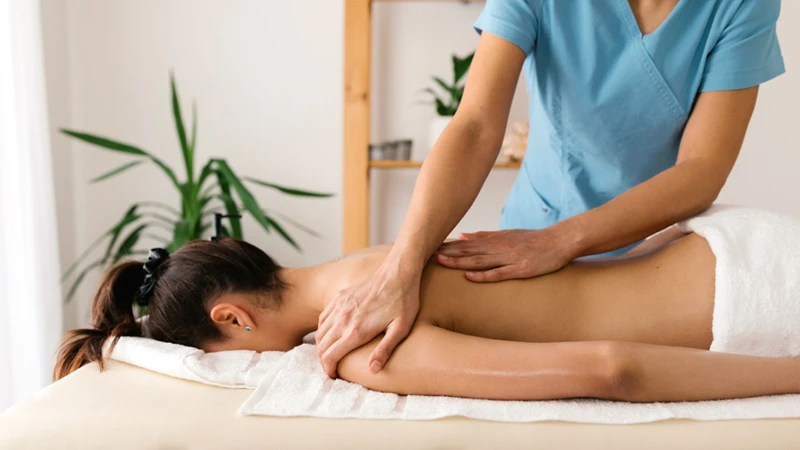
Therapy massage, also known as therapeutic massage, is a type of massage that focuses on treating physical and mental ailments. This type of massage is used to relieve pain, increase range of motion, reduce stress, and increase relaxation. It is also used to aid in recovery from injury, enhance physical performance, and alleviate emotional problems. It may also be used to improve overall health and wellness.
The goal of therapy massage is to help the body heal and restore balance. To achieve this, therapists use a variety of massage techniques, such as Swedish massage, deep tissue massage, trigger point therapy, and myofascial release. These techniques are designed to target specific areas of the body and address the cause of the ailment.
Benefits of Therapy Massage
Therapy massage has numerous physical and mental benefits, including:
- Reduction of stress and anxiety
- Improved circulation
- Reduction of pain and inflammation
- Improved range of motion
- Improved posture
- Increased relaxation
- Improved lymphatic drainage
Types of Therapy Massage
Therapy massage can be broadly divided into two main categories: clinical massage and relaxation massage.
- Clinical Massage – Clinical massage is used to treat specific conditions and ailments. It may be used to address musculoskeletal issues, such as pain, swelling, and stiffness. It may also be used to treat chronic conditions, such as fibromyalgia, arthritis, and migraines.
- Relaxation Massage – Relaxation massage is designed to help the body and mind relax. It is often used to promote overall wellbeing and improve sleep quality. This type of massage uses gentle strokes and can be used to reduce stress and tension.
Techniques Used in Therapy Massage
Therapy massage incorporates a variety of techniques, including:
- Swedish massage – a full body massage that uses long, gentle strokes
- Deep tissue massage – a more intense massage that focuses on the deeper muscle layers
- Trigger point therapy – a massage technique that targets and releases knots in the muscles
- Myofascial release – a technique that involves applying gentle pressure to the connective tissue
Therapy massage is a powerful tool for treating physical and mental ailments. It can help reduce pain, restore range of motion, reduce stress, and promote overall wellbeing. It is important to discuss your needs with your therapist so that they can tailor a massage session to meet your individual needs.
Benefits of Therapy Massage
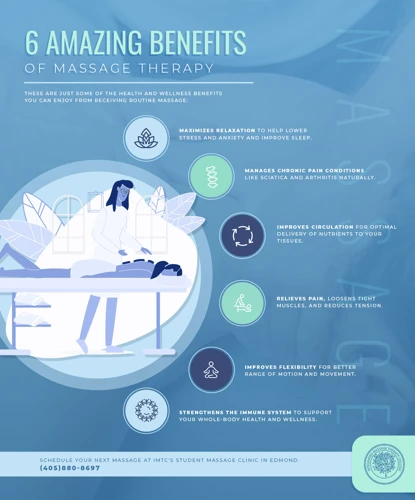
Stress Relief
Massage therapy is known to be a great way to reduce stress and anxiety. It can help to relax the body and mind, promoting a sense of well-being.
Improved Circulation
The improved circulation that results from massage therapy can help to improve and maintain healthy blood flow. This can help to reduce inflammation, and can also help to reduce the risk of heart disease, stroke, and other health issues.
Improved Mobility
Massage therapy can help to improve the range of motion and flexibility of the body. This can help to reduce pain and improve mobility, allowing for improved functioning of the body.
Improved Immune System
Massage therapy can help to improve the immune system, helping to fight off infections and diseases. It can also help to reduce fatigue and improve overall energy levels, allowing for better overall health.
Improved Posture
Regular massage therapy can help to improve posture, helping to reduce pain, improve balance, and improve overall strength.
Reduced Pain
Massage therapy can help to reduce muscle tension and pain. It can also help to reduce the symptoms of chronic pain, such as headaches and back pain.
Types of Therapy Massage
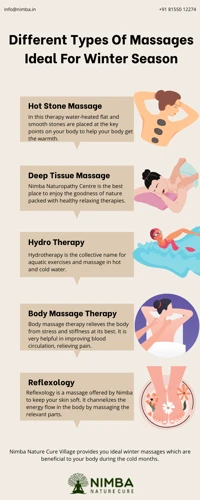
Swedish Massage
Swedish massage is the most popular type of massage. It involves gentle gliding strokes and kneading, as well as light, rhythmic, tapping strokes, on topmost layers of muscles. It helps to improve circulation, reduce stress and relax the body.
Deep Tissue Massage
Deep tissue massage is a type of massage that focuses on realigning deeper layers of muscles and connective tissue. It is especially helpful for chronically tense and contracted areas such as stiff necks, low back tightness and sore shoulders.
Sports Massage
Sports massage is specifically designed for people involved in physical activity. It combines techniques of Swedish massage and deep tissue massage to release chronic muscle tension. The focus is on the deepest layers of muscle tissue, tendons and fascia (the protective layer surrounding muscles, bones and joints).
Hot Stone Massage
Hot stone massage is a type of massage therapy that involves the use of smooth, heated stones. The heat from the stones helps to relax muscles, allowing the therapist to work deeper and more quickly.
Pregnancy Massage
Pregnancy massage is a type of massage therapy specially designed for pregnant women. It can help reduce pregnancy body aches, reduce stress, and ease muscle tension.
Shiatsu Massage
Shiatsu massage is an ancient Japanese massage technique. The therapist applies pressure to acupressure points on the body to help release tension and improve circulation.
Thai Massage
Thai massage is a type of massage that involves stretching and deep massage. The therapist uses hands, knees, legs and feet to move you into a series of yoga-like stretches.
Lymphatic Drainage Massage
Lymphatic drainage massage is a form of gentle massage that encourages the movement of lymph fluids around the body. The massage uses very light pressure and long, gentle, rhythmic strokes to increase the flow of lymph and reduce toxins in your body.
Techniques Used in Therapy Massage
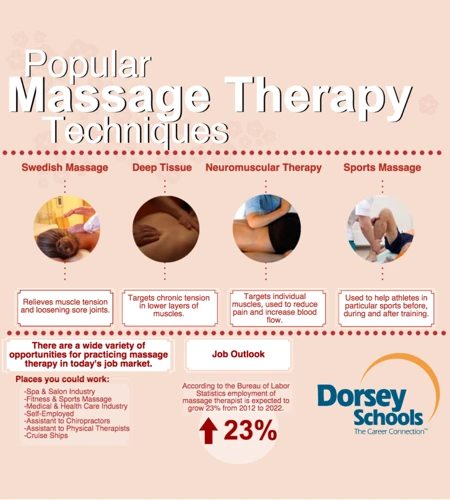
Effleurage
Effleurage is a light, sweeping massage stroke used to warm up the muscle tissues and prepare the body for deeper work. It helps relax muscles, improve circulation and reduce stress.
Petrissage
Petrissage is a massage technique used to knead the muscles, releasing tension and increasing circulation. It is often used to help reduce tension and break up knots in the muscles.
Tapotement
Tapotement is a massage technique used to stimulate and invigorate the body. It involves tapping, pounding and cupping the muscles, which helps improve circulation and stimulate the nervous system.
Friction
Friction is a massage technique used to break up scar tissue, reduce inflammation and increase circulation. It involves applying deep, circular pressure to targeted areas, which helps to break up adhesions in the muscle and connective tissue.
Vibration
Vibration is a massage technique used to relax the muscles and improve circulation. It involves using a vibrating device to massage the tissues, which helps to relax the muscles and reduce tension.
Finding a Massage Therapist
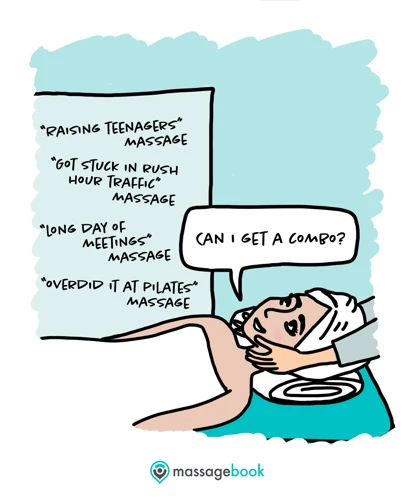
1) Certification: The best massage therapists are certified by national organizations such as the American Massage Therapy Association (AMTA) or the National Certification Board for Therapeutic Massage and Bodywork (NCBTMB).
2) Education: A reputable massage therapist will have a minimum of 500 hours of education from an accredited massage therapy school.
3) Licensure: Most states require massage therapists to be licensed, which requires passing a written and practical exam.
4) Specialization: Massage therapists may specialize in a particular type of massage, such as sports massage or Swedish massage.
5) Experience: Look for a massage therapist with a minimum of two years of hands-on experience.
6) Comfort Level: Make sure you feel comfortable with your massage therapist, as you’ll be spending a significant amount of time with them.
7) Referrals: Ask friends, family members and healthcare providers for referrals.
8) Reviews: Check out online reviews of massage therapists to get an idea of their reputation.
Preparing for a Therapy Massage
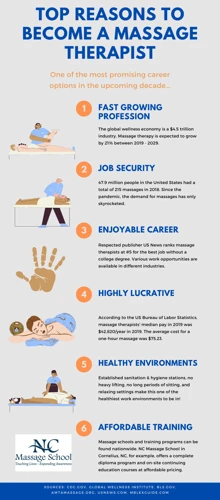
- Arrive Early: Arrive at least 15 minutes early for your massage session. This will give you time to fill out paperwork and make the most of your massage session.
- Discuss Your Needs: Before your massage, your therapist may ask you questions about your health history and current health condition. Be sure to answer honestly and provide as much detail as you can. This will help the therapist tailor the massage to your needs.
- Understand the Process: Before your massage, your therapist will ask you to remove any clothing that is necessary for the massage. They will also ask you to lie down on the massage table and make yourself comfortable. Make sure to ask any questions you may have about the massage process.
- Communicate With Your Therapist: During your massage, it is important to communicate with your therapist. Let them know if the pressure is too light or too strong. Also, let them know if you need to take a break or if you’re feeling uncomfortable. This will help them tailor the massage to your specific needs.
- Stay Hydrated: After your massage, it is important to stay hydrated. Drink plenty of water to help flush out toxins that were released during your massage.
- Relax: After your massage, take some time to relax. Try to avoid any strenuous activities for the rest of the day to allow your body to recover from the massage.
Aftercare for a Therapy Massage
- Drink Plenty of Water: Drinking plenty of water after a massage therapy session is highly recommended as it helps flush out the toxins released during the massage and keeps the body hydrated.
- Rest: After a massage therapy session, it is important to give the body time to rest and recover. Avoid any strenuous activities and try to get a good night’s sleep.
- Stretch: Stretching can help the body to relax and ease the soreness felt after the massage therapy session. It can also help the body to maintain its mobility.
- Avoid Alcohol: Alcohol consumption after a massage therapy session should be avoided as it can dehydrate the body and interfere with the healing process.
- Hot/Cold Therapy: Hot or cold therapy can be used to reduce inflammation and swelling in the area that was massaged. It can also help to relieve pain and discomfort.
Frequently Asked Questions
What is the difference between a therapy massage and a regular massage?
A therapy massage is a type of massage that focuses on treating specific medical conditions, while a regular massage is a massage that is done to relax and rejuvenate the body. The main difference is that a therapy massage is tailored to treat specific medical issues and offers deep tissue work, while a regular massage is more focused on relaxation and relieving stress. Therapy massage therapists use different massage techniques, such as Swedish massage, deep tissue massage, and reflexology, to help the patient achieve their desired results.
Are there any risks associated with therapy massage?
Therapy massage is generally safe, but there are some risks to consider. Those with certain medical conditions, such as cancer, diabetes, or high blood pressure, should consult their doctor before receiving massage therapy. People who are taking blood thinners or other medications should also consult their doctor before beginning massage therapy. Improper technique or too much pressure can lead to muscle strain, ligament damage, and nerve damage. People with heart problems should avoid massage therapy on the chest area. Additionally, massage can cause temporary soreness, bruising, and skin irritation.
What Types of Techniques are Used in Therapy Massage?
Therapy massage techniques vary depending on the type of massage being performed. Common techniques include Swedish massage, deep tissue massage, trigger point massage, sports massage, and acupressure. Swedish massage is the most widely used technique and is known for its long, gentle strokes. Deep tissue massage is used to address chronic pain and tension and is applied with deeper pressure. Trigger point massage is used to release muscle knots and spasms. Sports massage is used to improve performance, reduce fatigue, and prevent injuries. Lastly, acupressure is a form of massage that uses pressure points to improve circulation and reduce pain.
How Often Should I Receive Therapy Massage?
- Frequency: Depending on your individual needs, frequency of therapy massage can vary. Generally, once every two weeks can be beneficial.
- Chronic Conditions: If you have a chronic condition, such as arthritis or fibromyalgia, more frequent massages may be necessary.
- Injury Treatment: If you are receiving massage therapy to treat an injury or aggravated muscle, multiple visits may be recommended.
- Stress Management: Massage therapy is also used to reduce stress and relax. If you are using massage therapy for relaxation purposes, monthly or bi-monthly sessions are recommended.
Is Therapy Massage Covered by Insurance?
Therapy massages may be covered by health insurance depending on the individual policy and the type of massage. It is important to note that the coverage may extend only to those with a legitimate medical need, such as those with chronic pain or muscle tension due to an injury.
- What Types of Massage Are Covered? Generally speaking, health insurance companies will cover massage therapy for medical reasons when it is prescribed by a licensed doctor or physical therapist. This may include Swedish massage, deep tissue massage, and sports massage, depending on the individual policy.
- What Fees Are Covered? Health insurance may cover the cost of a massage therapist’s fee, as well as the cost of any supplies used during the massage. However, it is important to note that some policies may not cover the cost of any additional services such as aromatherapy or hot stone therapy.
- How to File a Claim? To determine if massage therapy is covered by health insurance, it is best to contact the insurance company directly. It is also important to check with the massage therapist to see if they accept insurance. Once coverage is confirmed, the massage therapist may need to provide the insurance company with a detailed receipt for the services provided. The insurance company will then process the claim and reimburse the patient for any fees covered.
In conclusion, therapy massage may be covered by health insurance depending on the individual policy and the type of massage. It is important to contact the insurance company directly to determine coverage and to make sure that the massage therapist accepts insurance.
Conclusion
Therapy massage includes a wide range of massage techniques and modalities that can provide many physical and psychological benefits. Massage therapy can be used to reduce stress, manage pain, improve circulation, and boost immunity. Different types of massage therapy include Swedish massage, deep tissue massage, and trigger point therapy, among others. Each type of massage has its own unique set of techniques and involves the use of pressure and manipulation of the body’s muscles and soft tissues. Massage therapists can customize a massage to meet the individual needs of the client.

